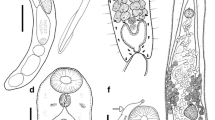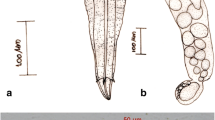Abstract
Red-tailed gigantocercous cercariae which developed in the euryhaline snailHydrobia ulvae Pennant (Prosobranchia, Hydrobiidae) in Denmark developed intoMesorchis denticulatus (Rudolphi 1802) Dietz 1909 (Echinostomatidae). Synonyms areStephanoprora denticulata (Rudolphi 1802) Odhner 1910,M. pseudoechinatus (Olsson 1876) Dietz 1909, andS. pseudoechinata (Olsson 1876) Odhner 1910. The rediae are cannibals devouring whole extraredial cercariae. The cercariae are actively ingested by small fish or carried by the respiratory current into their gill chambers. They encyst in the gill filaments.Gasterosteus aculeatus L.,Pungitius pungitius L. andPomatoschistus microps Krøyer are the most important second intermediate hosts in Danish waters, but all species of small fish, exceptAnguilla anguilla L., exposed to the cercariae were experimentally infected. Chickens were suitable laboratory hosts, whereasLarus spp. and other piscivorous birds function as natural final hosts in Europe and North America. Mammals may also be suitable hosts.
Similar content being viewed by others
References
Ankel A (1962)Hydrobia ulvae Pennant undHydrobia ventrosa Montagu als Wirte larvaler Trematoden. Vidensk Meddr dansk naturh Foren 129:1–100
Buck OD, Cooper CL, Crites JL (1976) Helminth parasites of the herring gull,Larus argentatus, from the Bass Island region of western Lake Eire. Proc Helminthol Soc Wash 43:233–234
Bykhovskaya-Pavlovskaya IE (1978) On the taxonomy of the family Echinostomatidae Dietz, 1909 (Trematoda). Parazit Sb Leningr 28:16–28 (In Russian)
Christensen NO, Roth H (1949) Investigations on internal parasites of dogs. K Vet og Landbohøjsk Aarsskr 1949:1–73
Ciurea I (1931) Les poissons de la Mer Noire comme source d'infestation par les trématodes de la famille des hétérophyidés et des échinostomidés. Archs roum Path exp Microbiol 4:289–299
Dollfus RPh (1963) Trématodes Digenea adultes chez des batraciens, reptiles, oiseaux. Ann Parasitol Hum Comp 38:29–61
Fraser PG (1974) The helminth parasites of aquatic birds from Loch Leven, Kinross: The trematodes of Laridae. Proc Roy Soc Edinb B 74:391–406
Guildal JA (1964) Some qualitative and quantitative investigations on the endoparasitic fauna of the Scandinavian-Baltic population of the black-headed gull (Larus ridibundus L.) K Vet og Landbohøjsk Aarsskr 1964:227–249
Krasnolobova TA (1971) Knowledge on the life cycle of the avian trematodeMesorchis pseudoechinatus Olsson, 1876 (Echinostomatidae Dietz, 1909). Tr Gelminth Lab 22:119–121 (In Russian)
Linton E (1928) Notes on trematode parasites of birds. Proc US Nat Mus 73:1–36
Loos-Frank B (1968) Der Entwicklungszyklus vonPsilostomum brevicolle (Creplin, 1829) (Syn.:P. platyurum (Mühling, 1896) Trematoda, Psilostomatidae). Z Parasitenkd 31:122–131
Nasir P, Scorza BJV (1968) Studies on freshwater larval trematodes. XVIII. The life cycle ofStephanoprora denticulata (Rudolphi, 1802) Odhner, 1910 (Trematoda: Digenea: Echinostomatidae). Z Parasitenkd 30:134–148
Nikitina EN (1979) Larval helminth fauna of invertebrates in the Krasnovodsk Bay. Kompl isslednie Kasp Morya Moskva 6:124–139 (In Russian)
Odhner T (1911) Nordostafrikanische Trematoden, größtenteils vom Weissen Nil (von der schwedischen zoologischen Expedition gesammelt). Res Swed Zool Exp Egypt and White Nile 1901 4:1–166
Olsson P (1876) Bidrag till Skandinaviens helminthfauna. I. K svenska Vetensk Acad Handl 14:1–35
Pemberton RT (1963) Helminth parasites of three species of British gulls,Larus argentatus Pont.,L. fuscus L. andL. ridibundus L. J Helminthol 37:57–88
Price EW (1933) The trematode parasites of marine mammals. Proc US Nat Mus 81:1–68
Reimer L (1964) Life-cycles of Psilostomatidae Odhner 1911, emend. Nicoll 1935 (Trematoda, Digenea). In: Ergens R, Rysavy B (eds) Parasitic worms and aquatic conditions. Symposium, Prague 1962, p 99
Reimer LW (1970) Digene Trematoden und Cestoden der Ostseefische als natürliche Fischmarken. Parasit Schr Reihe 20:1–143
Reimer LW (1970) Digene Trematoden von Anseriformes der Ostsee. Wiss Z pädag Hochsch “Liselotte Herrmann” Güstrow 1977(1):125–146
Reimer LW, Pav R (1973) Zur Helminthenfauna vonLarus canus L. von Brutgebieten der Ostsee. Wiss Z pädag Hochsch “Liselotte Herrmann” Güstrow 1973(2):87–92
Rudolphi CA (1802) Beobachtungen über die Eingeweidewürmer. Arch Zool Zoot 3(1):61–125
Skrjabin KI (1944) An analysis of the generic components entering into the composition of three trematode families: Opisthorchidae, Dicrocoeliidae and Echinostomatidae. Dokl Akad Nauk SSSR 44(7):299–301
Stunkard HW, Uzmann JR (1960) The life cycle of the digenetic trematodeStephanoprora denticulata (Rudolphi, 1802) Odhner, 1910. J Parasitol 48 Sect 2 (Suppl):23
Threlfall W (1968) Studies on the helminth parasites of the American herring gull (Larus argentatus Pont.) in Newfoundland. Can J Zool 46:1119–1126
Timon-David J (1955) Trématodes des goélands de l'ile de Riou. Ann Parasitol Hum Comp 30:446–476
Torres P, Figueroa L, Saldivia A (1983)Stephanoprora denticulata (Trematoda, Echinostomatidae) en gaviotas del sur de Chile. Bol Chil parasitol 38:33–34
Yamaguti S (1975) A synoptical review of life histories of digenetic trematodes of vertebrates with special reference to the morphology of their larval forms. Keigaku, Tokyo
Author information
Authors and Affiliations
Rights and permissions
About this article
Cite this article
Køie, M. The life-history ofMesorchis denticulatus (Rudolphi, 1802) Dietz, 1909 (Trematoda, Echinostomatidae). Z. Parasitenkd. 72, 335–343 (1986). https://doi.org/10.1007/BF00928744
Accepted:
Issue Date:
DOI: https://doi.org/10.1007/BF00928744




